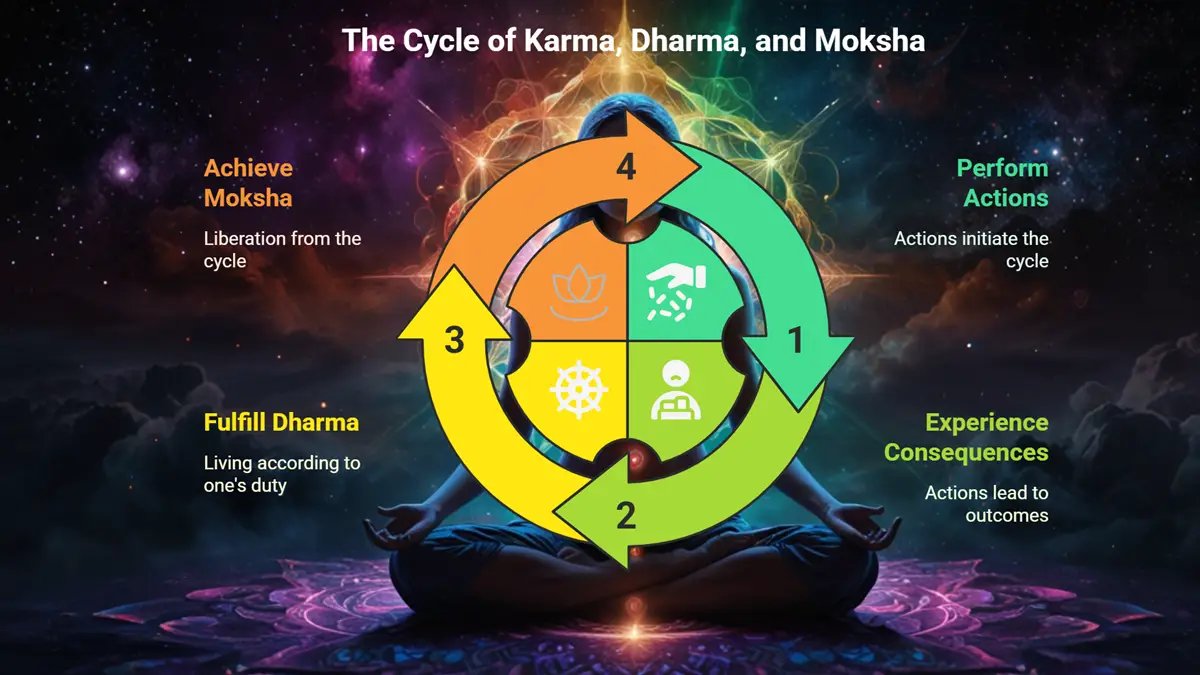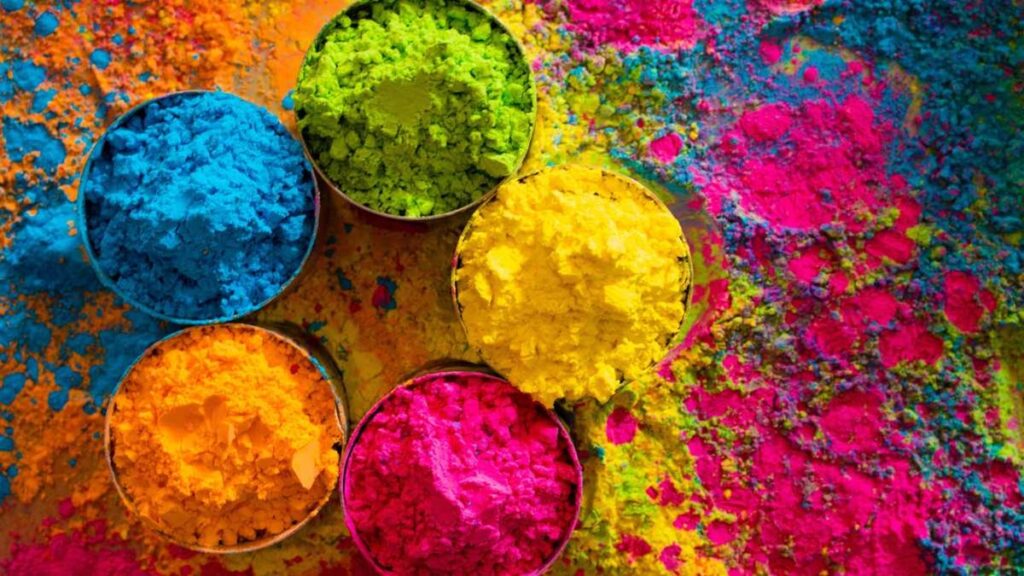“As you sow, so shall you reap.”
This timeless truth, echoed in many cultures, finds deep roots in Indian philosophy through the interconnected concepts of Karma, Dharma, and Moksha. These are not just abstract ideas from ancient texts — they form the very foundation of a meaningful, purposeful life.
Have you ever thought about why certain things happen to you, or why some people seem to have a steady sense of peace, no matter what they go through? Or maybe you longed for something more, for some greater realization that life cannot only be about accomplishment or survival? These inquiries about your life are answered within the rich spiritual framework that the Sanatan Dharma provides — a path that offers us both answers and peace.
In this blog, we’ll delve into these ageless pillars of Indian wisdom, myth-bust the law of karma, grasp what dharma really is, and take a deep dive into the moksha meaning — the ultimate human end goal. Whether you’re spiritually interested or deeply devoted, becoming familiar with these concepts can help you live more mindfully, with greater clarity and purpose.
What is Karma? – The Law of Cause and Effect
The word Karma originally derived from the Sanskrit root “Kri,” which means “to do,” the concept of karma is primarily understood as action—any action, not merely physical acts but thought and intent as well. While karma, as a term is universal in the contexts of Hinduism, Buddhism, and Jainism, karma itself is more than just a concept; it is a principle—the principle that every action has a reaction that comes back to the individual in some way, thus influencing their present and future experiences.
Karma is frequently thought of as fate, but it is not about predetermined destiny; it is about choice and how we are responsible for our choices. The law of karma are like nature’s justice – impartial and precise. In many Eastern traditions, karma is associated with reincarnation (samsara) where the nature of a person’s karma determines their subsequent lives.
The Bhagavad Gita on karma says a strong message: we are deserving of action, not the result of action. This independence from outcome cleanses our motivation and frees us from the chain of karmic bondage. If we perform action with knowledge and without egotistic motive, karma becomes a means of inner liberation.
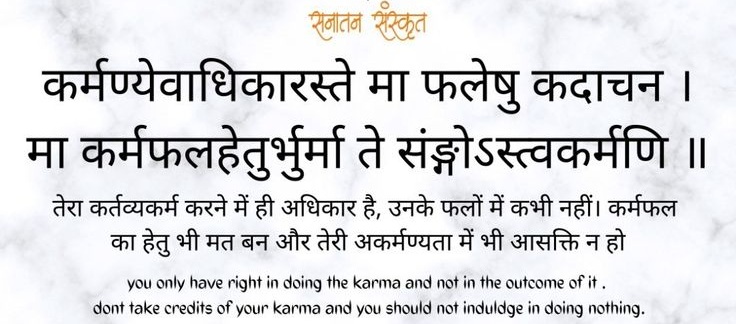
How Karma Works
Karma isn’t punishment or reward — it’s balance. It works silently across lifetimes. There are three types of karma:
- Sanchita Karma: Sanchita Karma is the aggregate collection of all past-life karmic impressions. It becomes an immense reservoir of actions that have not yet appeared in our present experience.
- Prarabdha Karma: Prarabdha Karma is the specific portion of Sanchita Karma chosen to be realized in this life. It determines our current situation and is already underway, beyond modification.
- Agami Karma: Agami Karma is the karma we create through present actions, thinking, and intentions. It contributes to our karmic cycle and will affect future lives and experiences yet to be lived.
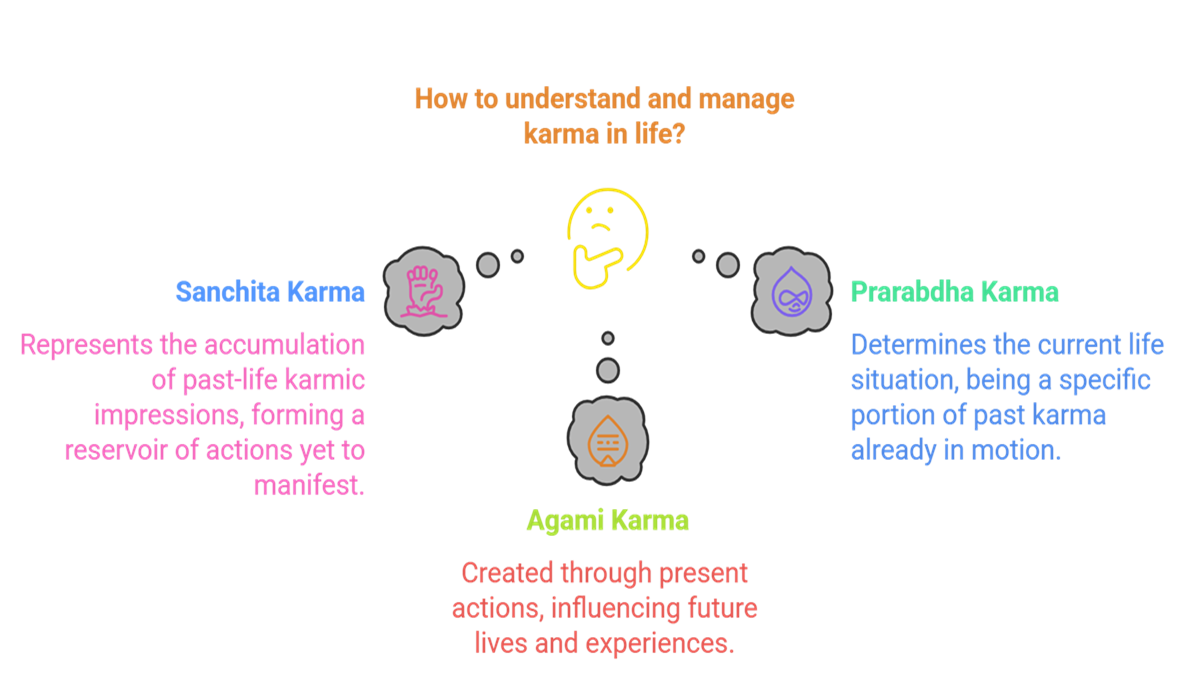
How Karma Affects Your Life
Karma shapes the events, relationships, and experiences in your life. Are you noticing repeating patterns? Is there something that is always testing you? Usually, it’s your past karma trying to work itself out. Now here comes the good news; karma is not static. With awareness and the right action, we can alter our karmic journey.
What is Dharma? – The Path of Righteousness
Dharma is one of the deepest and most important concepts of Indian philosophy, but there is often tremendous oversimplification of it. While it is usually translated as “duty” or “righteousness,” it means far more. Dharma is the cosmic order — the moral and ethical frameworks that uphold the orderly universe, promote social harmony, and govern an individual’s behaviour based on own nature.
In Sanatan Dharma, there are many forms of dharma:
Sanatana Dharma: The eternal, universal principles like truth, compassion, and non-violence that guide righteous living for all beings.
Svadharma: One’s personal duty aligned with their nature, role in society, and stage of life, as per dharma.
What Dharma Means in Daily Life
Living your dharma means being aligned with what feels like your truth. For a teacher this may be to teach — for a parent this may be to nurture. Dharma isn’t rigid — it is affected by context, and can change as you progress inwardly. When you live a dharmic life there is a sense of peace; when you go against it brings inner turmoil and a lot of karmic consequences.
Dharma and Karma: A Powerful Connection
Whenever your actions (karma) are congruent with your true dharma—your inner duty and moral path—you create positive karma. This balance leads to spiritual development, the alleviation of the karmic load, and brings the soul closer to liberation (moksha).
What is Moksha? – The Ultimate Goal of Liberation
In the midst of these cycles of birth, death, and rebirth — samsara — is the soul’s greatest desire: Moksha. Moksha meaning is freedom from the cycle of karma and reincarnation. It is the final aspiration in most Indian religions, including Hinduism, Jainism, and Buddhism, where it is also called nirvana. Moksha is the state of absolute freedom — not only from the physical cycle of life, but also from suffering, sorrow, and the constraints of the material world. It is the reunion of the soul with the Divine, beyond all forms of suffering and illusion.
Why Moksha is Important
Without moksha, we are caught in the unending cycle of desires, actions, and consequences. In the Vedic worldview, true and permanent happiness does not originate in material achievement of any kind, but rather in the realization of one’s inner spiritual nature. Moksha is a departure from ignorance, the instant the soul ceases to be in the dark about its true nature and realizes liberation. Moksha marks the conclusion of our spiritual journey. It is the last separation from samsara and the last transition into eternal peace.
How Moksha Can Be Obtained
Moksha is described as supreme happiness and freedom, achieved through yoga, meditation, and deep understanding of your essential nature. Multiple ancient sages, or scriptures, detail several paths to reach moksha:
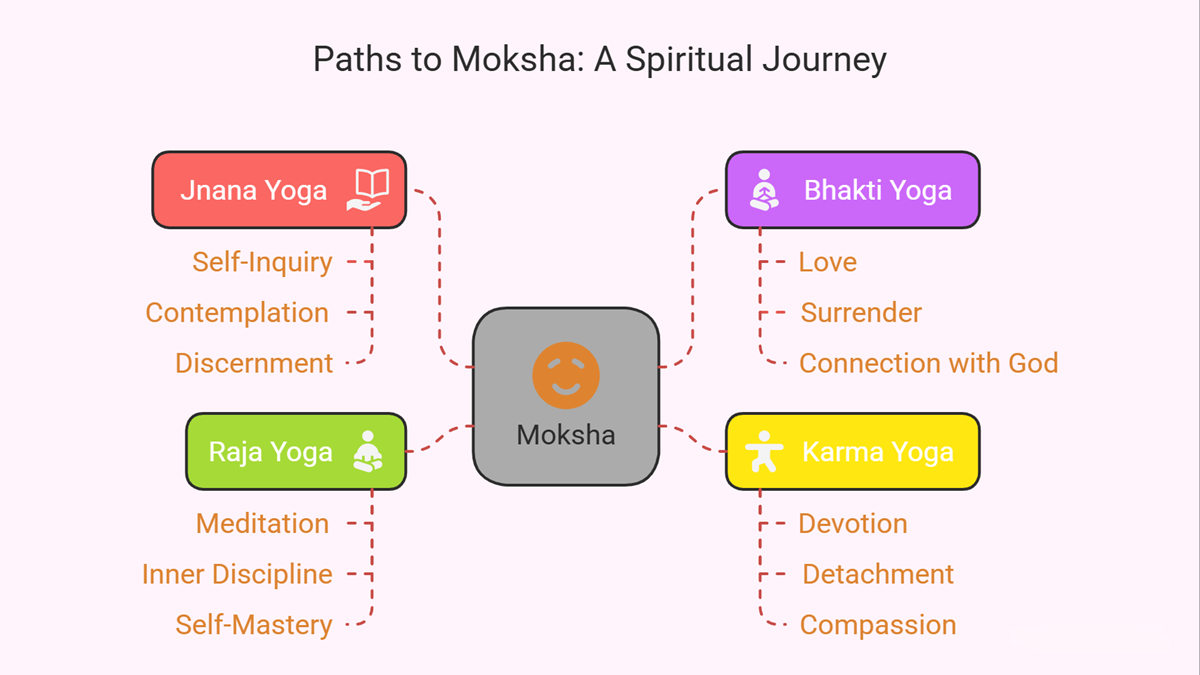
Jnana Yoga: Jnana Yoga—also referred to as the “path of knowledge”—is one of the main yogic paths defined in the Bhagavad Gita and focuses on self-inquiry, contemplation, and discernment, and the goal of discovering the essence of reality, the Self, and the universe. Jnana Yoga is not merely intellectual learning but a journey of inner transformation and actual realization of truth.
Bhakti Yoga: the path of bhakti to the Divine – emphasizes love, surrender, and a heart-felt connection with God. Some practices are chanting mantras, singing bhajans, reciting prayers, and devotional service. With Bhakti Yoga, we develop a personal relationship with the Divine, we cultivate inner joy and peace, and we continue to develop spiritually with understanding of oneness with the divine.
Karma Yoga: the way of selfless action – teaches to do one’s work with devotion, but not with attachment to the outcome. It instructs to act with compassion, integrity, and detachment, and to give all actions to the Divine. This practice cleanses the mind, decreases ego, and results in inner freedom and spiritual growth.
Raja Yoga: also referred to as Classical Yoga or the King of Yogas – is the path of meditation, inner discipline and self-mastery. It focuses on developing control of the mind and emotions to attain inner peace and spiritual realisation. Raja Yoga is a complete system described in the Yoga Sutras of Patanjali, and is united in the eight limbs of yoga (Ashtanga Yoga) which are essentially the steps to liberation.
These eight limbs are:
- Yama – moral restrictions such as non-violence and honesty
- Niyama – personal observations such as chastity and contentment
- Asana – physical postures that prepare the body for stillness
- Pranayama – breath control to manage life force energy
- Pratyahara – withdrawal of the senses from external distractions
- Dharana – concentrated focus on one point or concept
- Dhyana – deep, uninterrupted meditation
- Samadhi – the state of super-consciousness and unity with the Divine
The Bhagavad Gita on karma beautifully illustrates that by doing one’s dharma unselfishly — without attachment — one eventually moves towards liberation.
Real-Life Application: Living with Awareness
India is sometimes called a karma bhoomi — a land where each action carries profound spiritual meaning. But in reality, wherever you are, life is your karma bhoomi. Every decision you make has the ability to mold your fate and nudge you closer (or further away) from your higher self.
Transforming Life Through Spiritual Wisdom
Understanding karma makes us more aware of our actions. Having knowledge of dharma provides us with clarity regarding our duties and responsibilities. Desiring moksha reminds us that survival or success in life is not enough but evolution and awakening.
Daily Practices for Spiritual Alignment
- Self-reflection: What karma are you creating today?
- Meditation: Silence the noise, connect with your inner self.
- Seva (Service): Serve others without expectation — pure karma yoga.
- Study Scriptures: The Gita, the Upanishads, and other sacred texts offer timeless wisdom.
Karma, Dharma, and Moksha are the essence of the spiritual principles of Sanatan Dharma, and can help guide us to live more consciously and with purpose and meaning. The laws of karma allow us to understand that each action, thought, and intention has consequences, not under the label of punishment, but rather provocations for us to grow. Dharma enables us to act in accordance with our true nature and fulfill the duty we have each been uniquely appointed to do with honesty and kindness to others.
The final end goal, Moksha, means freedom from the continuous cycle of birth and death. It is the realization of the soul, achieved through selfless service, devotion, knowledge, and meditation. The Bhagavad Gita on karma states that it is possible to obtain moksha or liberation while we are living in this world provided we do not attach our self to the fruits of our action, while undertaking our duty.
This life is our karma bhumi—a place of cultivation and realization. As we align our karma with dharma, we move closer each step to eternal peace and spiritual liberation.

